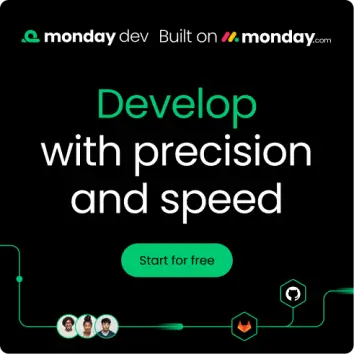Program Increment (PI) Planning is a cadence-based event that aligns all Agile Release Train (ART) teams to the same mission and vision. It’s a crucial element of the Scaled Agile Framework (SAFe) that organizations need to master if they want to develop and manage successful products.
Increasingly, AI-powered tools — like those found in monday dev — support this alignment by forecasting capacity, optimizing work allocation, and flagging risks automatically — helping teams plan smarter, faster.
In this guide, you’ll learn why organizations use PI planning, who’s involved, what the agenda covers, and how to run successful PI planning events. We’ll also show you how to bring multiple teams together and streamline the PI planning process with monday dev.
Try monday dev
"monday dev empowered us to optimize our GTM approach, resulting in faster, more dependable deliveries"
Steven Hamrell | Director of Product Management
"monday dev empowers us to manage the entire development process on one platform so we can speed up product delivery and improve customer satisfaction"
Mitchel Hudson | Head of Technology
"We're operating in an open, deep trusting, transparent environment with no silos of information. It's about completely opening access to everyone who needs it."
Alan Schmoll | Executive Vice President, Vistra PlatformKey takeaways
- PI planning is a cadence-based, strategic event that aligns all ART teams to a shared mission and vision for the next program increment.
- Successful PI planning requires collaboration, early risk management, and strong stakeholder alignment to ensure predictable delivery and business value.
- The process involves structured steps — from presenting business context and product vision, to breakout planning and retrospective — helping teams commit to collective outcomes.
- Leveraging software like monday dev, teams can visualize dependencies, automate reporting, and use AI for smarter, faster planning — even with distributed teams.
- Best practices include regular scheduling, clear Agile roles, active retrospectives, and adapting PI planning for both in-person and remote collaboration to maximize success.
What is PI planning?
Program increment (PI) planning is a key event in the Scaled Agile Framework (SAFe), where multiple teams within the same Agile Release Train (meet to align on goals and plan work for the upcoming program increment.
How long does PI planning take?
PI planning typically occurs every 8 to 12 weeks, but organizations can adjust the timing to their needs. For instance, some organizations prefer 8-week intervals for more agility, while others choose 12-week intervals to align with financial quarters. If sprints are 2 weeks long, one PI consists of 4 to 6 sprints, providing a consistent rhythm for planning and alignment.
Whatever cadence organizations choose, PI planning has a regular, predictable schedule. It’s a fixed time-boxed event that usually lasts for two days. The consistent cadence ensures teams have regular opportunities to synchronize, plan, and adapt their work across the Agile Release Train.
PI planning vs. sprint planning
PI planning and sprint planning are closely linked, yet address different needs at varying levels of scale and detail. Here’s a comparison table highlighting the key differences:
| Feature | PI planning | Sprint planning |
|---|---|---|
| Scope | Strategic objectives and roadmap — program level | Detailed user stories and tasks — team level |
| Timeframe | 8–12 weeks | 1–2 weeks |
| Participants | Multiple teams | Single team |
| Duration | 2+ days | 2–4 hours |
| Outputs | PI objectives, program board, risks, roadmap | Sprint goal, sprint backlog |
Sprint planning builds directly from PI objectives by translating broad, strategic goals into actionable tasks for the team’s next sprint. Each sprint is designed to make steady progress toward the program’s key outcomes, ensuring that day-to-day work remains aligned with organizational priorities and that teams deliver value consistently throughout the PI window.
Who participates in PI planning?
Because of its collaborative nature, PI planning involves multiple perspectives. Here are the key roles and responsibilities:
Role Responsibilities Release Train Engineer (RTE) Facilitates the event, manages risks/dependencies, aligns teams, tracks objectives Product Manager Presents program vision, prioritizes workflows, updates roadmap post-planning Product Owner Maintains backlog, defines user stories, ensures team priorities align with program goals Scrum Master Coaches teams, removes impediments, enforces Agile principles, manages timebox Developers & Testers Participate in breakouts, refine user stories, identify dependencies, draft PI objectives Other stakeholders (business owners, architects, executives, customers) Provide context, feedback, and approvals
Why do PI planning?
The goal of PI planning is to align releases, foster collaboration, manage risks, improve predictability, and ensure teams work efficiently toward shared business goals. While it requires significant time and effort, the benefits almost always outweigh the costs in large-scale Agile development.
Here are the key reasons organizations invest in PI planning:
- Alignment and visibility: All teams within the ART connect to the business context and vision, ensuring clarity on priorities and upcoming work.
- Collaboration and coordination: The event brings teams together to discuss dependencies, foster cross-team collaboration, and make real-time decisions.
- Risk management: Potential issues are surfaced early, giving teams the chance to develop mitigation plans before execution.
- Planning and predictability: With AI-powered predictive analytics, teams achieve more accurate forecasts and build stakeholder confidence in their commitments.
- Resource utilization: Capacity and demand can be balanced more effectively, preventing teams from being overloaded.
- Motivation and clarity: By seeing the bigger picture, teams understand their role in the program and stay motivated around shared goals.
- Stronger networks: Whether in person or remote, the event strengthens trust and relationships across teams and stakeholders.
What are the steps involved in PI planning?
PI planning follows a structured agenda that guides Agile teams through strategic alignment, planning, review, and commitment for the next program increment. Here are the 9 steps involved:
- Business context presentation: Senior leadership shares the current business environment, market outlook, and high-level goals to set the strategic context for teams.
- Product vision presentation: Product managers outline the program vision, key priorities, and the main features slated for development.
- Planning context and expectations: The Release Train Engineer explains the PI planning process, clarifies objectives, and sets expectations for outcomes.
- Team breakouts: Individual teams review capacity, break down features into user stories, and draft initial plans, identifying dependencies and risks.
- Draft plan review: Teams present their first draft plans, including PI objectives, risks, and dependencies, for feedback from other teams.
- Management review and problem-solving: Management facilitates the resolution of cross-team dependencies and roadblocks, ensuring alignment and feasibility.
- Risk identification and resolution: Teams collectively assess and categorize risks as resolved, owned, accepted, or mitigated, then vote on confidence in meeting objectives.
- Rework and confidence vote: Teams adjust plans based on feedback and risk assessment, reworking drafts for a higher confidence score in their deliverables.
- Retrospective and next steps: The Release Train Engineer leads a closing retrospective to capture what worked, what could improve, and actionable lessons for future PI events.
This step-by-step structure keeps the PI planning process organized, ensures stakeholder alignment, and drives collective commitment to shared objectives for the increment.
What are some best practices for PI planning?
Some of the best practices for effective PI planning focus on preparation, stakeholder alignment, clear communication, risk management, and leveraging technology for remote teams.
- Ensure organizational readiness: Schedule PI planning events regularly and communicate them well in advance so all stakeholders can participate; this sets expectations and supports full-team engagement.
- Prepare program vision and content: Share the business mission, current roadmap, and product vision with all team members before the event, so everyone is aligned on priorities and the “why” behind key features.
- Organize logistics for collaboration: Set up physical or virtual meeting spaces to support large group discussions and team breakouts, and make sure everyone has the right tools for clear participation — including video conferencing for remote/hybrid teams.
- Manage scope and participation: Clarify the scope of planning, identify essential team members, and confirm roles like Scrum master, Product owner, and Release Train Engineer. Encourage a shared understanding of responsibilities and priorities.
- Promote open communication: Facilitate regular check-ins and feedback sessions to surface dependencies and risks early; foster honest, respectful dialogue to solve problems and improve plans.
- Proactively identify and address risks: Early risk identification and categorization (resolved, owned, accepted, mitigated) improves transparency and confidence in the final plan. Document and track risks as the increment progresses.
- Run engaging retrospectives: End each PI planning event with a retrospective, so teams can reflect on what worked well, what needs improvement, and actionable ideas for next time — helping drive continuous improvement.
- Leverage digital tools: Use AI-powered planning software like monday dev to visualize dependencies, track objectives, and facilitate collaboration, especially for distributed teams.
By following these best practices, organizations can increase engagement, alignment, and the likelihood of achieving program goals throughout each increment.
How to prepare for a PI planning event
Here are ten essential steps to ensure your organization is well-prepared for a successful PI planning event.
- Understand and communicate the purpose: Ensure all participants, especially executives and management, clearly understand the goals of PI planning. Communicate that the aim is to create an emergent roadmap and identify potential obstacles.
- Schedule well in advance: Plan the event for the next quarter at the end of the current quarter. Ensure the availability of all key stakeholders and leaders.
- Prepare the program vision and context: Determine the program vision and purpose in advance. Ensure program leaders and business stakeholders know how to convey this information.
- Arrange appropriate facilities: Book a large room that can accommodate about double the number of expected attendees. Ensure proper setup for remote participants, such as video conferencing equipment.
- Refine the backlog: Review and refine the product backlog. Ensure user stories and features are well-defined and prioritized.
- Align stakeholders: Engage with business owners and stakeholders to understand the priorities and expectations.
- Plan logistics: Arrange the necessary tools, resources, and materials. Set up digital collaboration tools if needed.
- Prepare an agenda: Create a detailed agenda for the two-day event. Include time for business context, vision presentations, team breakouts, plan reviews, etc.
- Pre-PI planning: Each team should conduct its own pre-PI planning session to prepare initial plans and identify potential risks and dependencies.
- Set up a program board: Prepare a physical or digital program board to visualize features, dependencies, and milestones.
Modern platforms like monday dev now use AI to transform backlog items, requirements, and meeting notes into actionable user stories and tasks — reducing manual prep and improving quality.
Try monday devHow to run a PI planning event
Here’s how a typical PI planning agenda plays out over 2 days:
Day 1 agenda
The first-day agenda includes an overview of the business context, product vision, and architecture, followed by detailed team planning and initial reviews of those plans.
| Session | Purpose | Details |
|---|---|---|
| Business context | Senior leader presents the state of the business, portfolio vision, and customer needs | – |
| Product/solution vision | Product manager shares the current product vision and top ~10 features | – |
| Architecture vision & practices | System architect presents the architecture vision; dev managers outline best Agile practices | – |
| Planning context | RTE explains the planning process and expected outcomes | – |
| Team breakouts #1 | Teams estimate capacity, identify backlog items, and refine features into stories | AI-powered scenario simulation lets teams test allocations and schedules instantly |
| Draft plan review | Teams present draft PI objectives, risks, and dependencies | Stakeholders (Business Owners, PMs, etc.) provide feedback |
| Management review/problem-solving | Leadership and RTE resolve dependencies, negotiate scope, and ensure feasibility | – |
Day 2 agenda
The second-day agenda lets teams finalize their plans, address risks, and align on objectives for the upcoming PI. It concludes with a confidence vote to ensure everyone is committed to the plan and a retrospective to improve future PI planning events.
| Session | Purpose | Details |
|---|---|---|
| Planning adjustments | Management presents results from Day 1 and any scope changes | – |
| Team breakouts #2 | Teams refine plans, finalize objectives, and adjust based on feedback | Business owners assign business values and rank objectives |
| Final plan review | Teams present finalized PI objectives, risks, impediments, and dependencies | Business owners must approve plans, even if adjusted |
| ART risks | Teams categorize risks from final plan review | Resolved: no longer a risk Owned: assigned to a person/team Accepted: acknowledged, unavoidable Mitigated: strategies in place to reduce impact |
| Confidence vote | Teams vote using “fist of five” | 3+ avg: plan accepted Below 3: rework required 2 or lower: concerns added to risk list or require re-planning |
| Plan rework (optional) | Teams adjust plans if confidence is too low | – |
| Retrospective & next steps | RTE facilitates lessons learned | Captures improvements for future PI planning events |
monday dev Testimonials

"monday dev empowered us to optimize our GTM approach, resulting in faster, more dependable deliveries"
Steven Hamrell | Director of Product Management
"monday dev empowers us to manage the entire development process on one platform so we can speed up product delivery and improve customer satisfaction"
Mitchel Hudson | Head of Technology
"We're operating in an open, deep trusting, transparent environment with no silos of information. It's about completely opening access to everyone who needs it."
Alan Schmoll | Executive Vice President, Vistra PlatformWhat happens after a PI planning event?
By following these post-PI planning activities, organizations can ensure that plans are effectively implemented and continuously improved throughout the program increment.
- Next steps: To move objectives forward, teams coordinate calendars to arrange daily standups and iteration meetings.
- Documentation: Teams transcribe objectives, user stories, and the program board into tools like monday dev and update roadmaps based on program objectives.
- Execution: ARTs begin implementing the plans outlined during PI planning and delivering value according to the commitments.
- Post-PI planning events: Further planning sessions involving stakeholders from all Agile Release Trains (ARTs) within the Solution Train take place to ensure synchronization and alignment. Teams present plans, explain objectives, and share milestones and timelines for each iteration and ART.
- Continuous improvement: Teams hold regular Inspect and Adapt (I&A) sessions throughout the increment, reflecting on progress, identifying areas for improvement, and adapting plans as needed to optimize performance.
- Customer feedback: Product owners actively seek and incorporate feedback from customers and end-users so future plans align with customer expectations.
Common PI planning pitfalls to avoid
Here are ten common pitfalls to avoid in your PI planning.
- Insufficient preparation: Not providing enough context or vision before the event and failing to have a clear backlog or prioritized features ready.
- Poor time management: Allowing discussions to run over and disrupt the agenda and not allocating enough time for team breakouts or plan reviews.
- Lack of stakeholder engagement: Not involving key business stakeholders throughout the process and failing to get proper buy-in from leadership.
- Ignoring dependencies: Failing to identify and manage cross-team dependencies and not visualizing dependencies on the program board.
- Overemphasis on estimation: Spending too much time on granular details at the expense of other activities and losing sight of the big picture.
- Neglecting team dynamics: Not promoting a positive and inclusive environment for collaboration. Failing to address conflicts or issues promptly.
- Skipping the confidence vote: Not conducting or taking the team confidence vote on the plan seriously.
- Forgetting to review past PIs: Not looking back at previous PI performance to inform current planning.
- Neglecting retrospectives: Skipping or rushing through the planning retrospective and not implementing improvements based on feedback from previous sessions.
- Challenges with virtual planning: Failing to adapt the planning process effectively for distributed teams and using inadequate remote collaboration tools.
Using monday dev for PI planning
Built on monday.com Work OS and packed with versatile features, monday dev enables teams and stakeholders to connect and collaborate at every step of the PI planning process. Its built-in AI actions help automate reporting, track team progress, and generate dashboards with predictive analytics, making it easier to monitor PI health and proactively manage objectives.
AI-powered PI planning
Traditional PI planning relies heavily on manual tracking, spreadsheets, and static boards. monday dev brings AI into the process — automatically surfacing dependencies, forecasting team capacity, and turning backlogs into actionable plans. This makes PI planning faster, more accurate, and far more scalable for distributed teams.
Plan with customizable boards
You can adapt customizable boards in monday dev to support every aspect of PI planning. For instance, a program board gives a high-level view of features, dependencies, and milestones across teams, while team boards let individual groups track their PI objectives and break them down into actionable items.
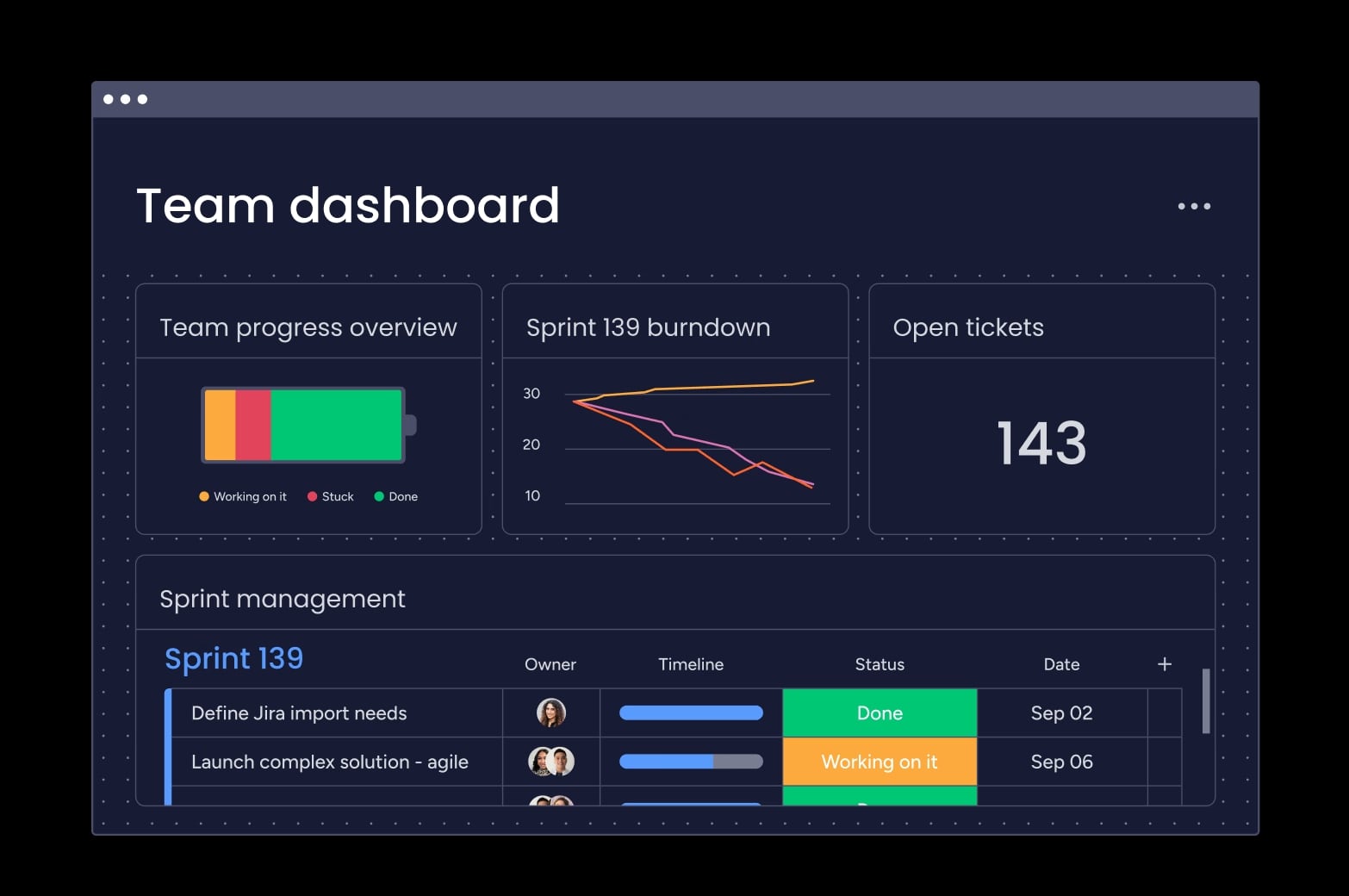
Collaborate in real time
Collaboration is seamless, with real-time updates that allow teams to work on plans simultaneously and instantly see changes, plus built-in comments and discussions to address dependencies, risks, and adjustments as they come up.
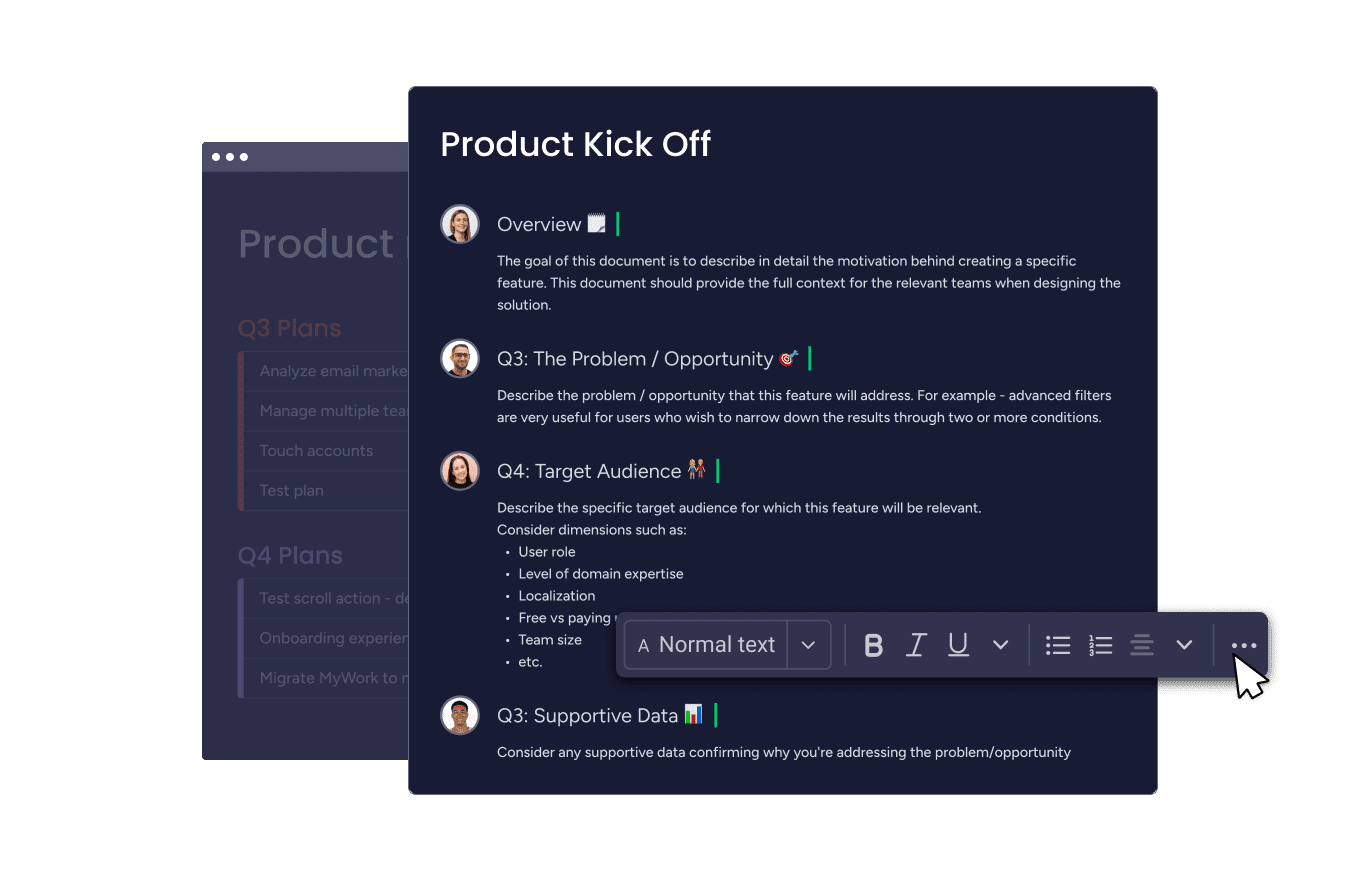
Visualize work with multiple views
Visualization features make PI planning easier, whether through Gantt charts that map out timelines, features, and dependencies across the program increment, or Kanban boards that help teams manage their backlog and organize work for the upcoming PI.
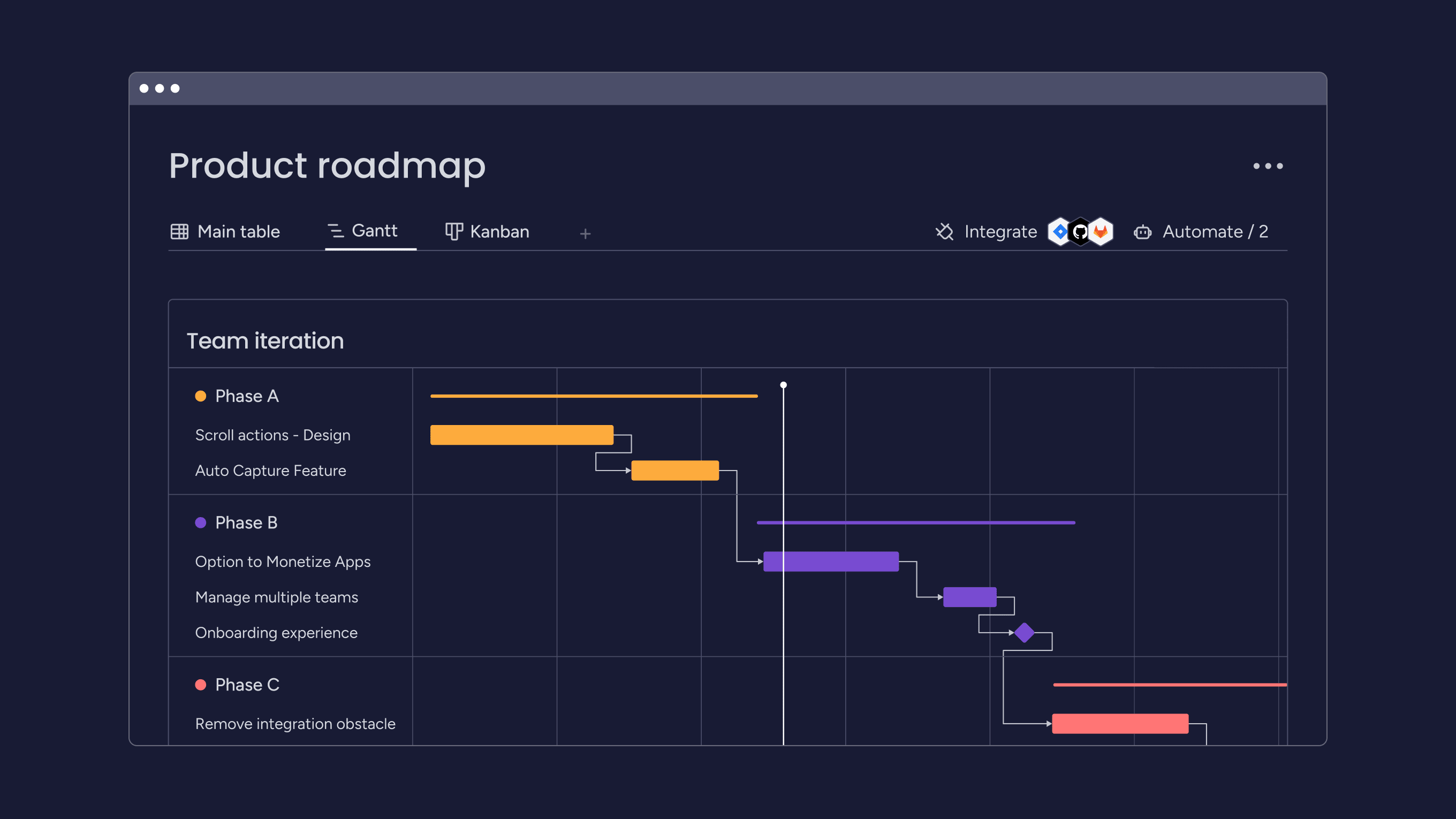
Connect tools and automate workflows
Integration features let teams connect monday dev with existing development tools to pull in relevant planning data, while automations can notify team members of updates or changes to keep everyone aligned.
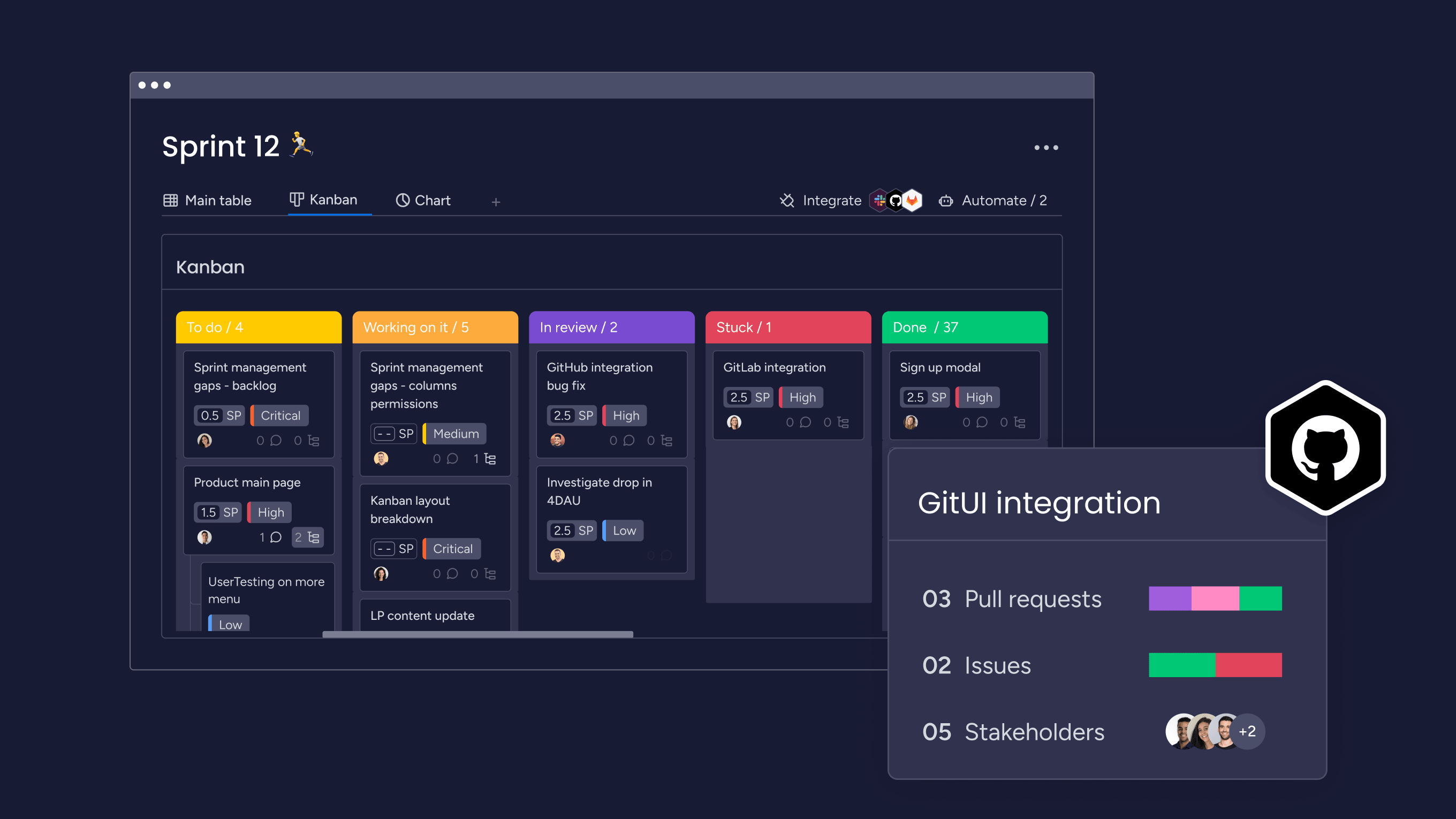
Track progress with AI-driven reporting
Use the reporting features to monitor the advancement of PI objectives throughout the increment. Create dashboards to visualize team capacity, risks, and other key metrics for PI planning. Use built-in AI actions to automate reporting and predictive analytics, giving teams and stakeholders live, actionable insights into planning health.
Try monday devStreamline your PI planning
Successful PI planning relies on the active participation and alignment of all team members and stakeholders. With monday dev, you have a flexible platform to provide the technical infrastructure, but the event’s success ultimately depends on effective facilitation and team engagement.
Try monday dev to see how you can streamline your PI planning process and get everyone on the same page.
Try monday devFAQs
What is PI planning in SAFe?
PI planning in SAFe is a structured, two-day event that occurs every 8-12 weeks, where multiple Agile teams, stakeholders, and leaders align on shared objectives for the upcoming program increment. It drives team collaboration, dependency mapping, and a unified delivery roadmap, ensuring alignment with the organization's vision and strategy over the next 8-12 weeks.
What is PI planning in Scrum?
In Scrum, PI planning is adapted for coordinating across several Scrum teams. These teams meet at regular intervals to prioritize features, align backlogs, and sync on dependencies — especially useful if multiple teams need to coordinate releases or collaborate on shared goals outside the single-team sprint focus. This adapted version of PI planning allows Scrum teams to maintain their sprint-based approach while benefiting from the alignment and coordination that PI planning provides.
What's the difference between PI planning and sprint planning?
PI planning is a strategic event that occurs every 8-12 weeks and aligns multiple teams on goals and plans for an entire program increment. In contrast, sprint planning is a tactical event that happens at the start of each 1-2 week sprint, focusing on a single team's detailed work plan for that sprint. While PI planning sets the broader vision and objectives for the PI, sprint planning breaks down those objectives into specific tasks and user stories for immediate execution.
What's the difference between PI planning and Big Room planning?
PI Planning and Big Room Planning are essentially the same event, with "Big Room Planning" being an alternative name for PI Planning. Both refer to a large-scale planning event involving multiple teams that typically occurs every 8-12 weeks. The terms are often used interchangeably, with "Big Room Planning" emphasizing the physical aspect of having many people in one large room, while "PI Planning" focuses on its role in the Scaled Agile Framework (SAFe).
What are the key outputs of PI planning?
The key outputs of PI planning are committed PI objectives, a program board with feature delivery dates and dependencies, and a prioritized backlog for upcoming iterations. Teams also identify risks, assign business values to objectives, and agree on milestones for the increment.
What tools are best for remote PI planning?
For remote PI planning, tools like monday dev support real-time collaboration, objective tracking, and visual management of dependencies. Other effective platforms include Miro, Mural, Piplanning.io, and Kendis, which provide digital workspaces, planning boards, and seamless communication for distributed teams.
How do you measure the success of a PI planning event?
Success in PI planning is measured by team alignment on objectives, backlog completion rates, delivery against milestones, and business value achieved. Metrics include velocity, user story completion, and customer satisfaction. Post-event retrospectives help assess gaps and drive ongoing improvement for future PIs.
 Get started
Get started 


